Brazil Advertising Market Outlook to 2030
By Channel Mix, By Buying Method, By Industry Verticals, By Objective/Funnel Stage, By Advertiser Size, and By Region
- Product Code: TDR0238
- Region: Central and South America
- Published on: August 2025
- Total Pages: 110
Introducing the World's FirstPay-Per-Section Market Reports
Why pay for the full report when you need just a part?
Start Building Your Report
Scroll down to see available sections
Report Summary
The report titled “Brazil Advertising Market Outlook to 2030 — By Channel Mix, By Buying Method, By Industry Verticals, By Objective/Funnel Stage, By Advertiser Size, and By Region” provides a comprehensive analysis of Brazil’s advertising industry. The report covers the overview and genesis of the sector, overall market size in terms of ad expenditure, detailed market segmentation; trends and developments, regulatory landscape, advertiser-level profiling, issues and challenges, and competitive landscape including competition scenario, cross-comparison, opportunities and bottlenecks, and company profiling of major agencies, media owners, platforms, and adtech. The report concludes with future market projections based on ad spend volumes, impression/GRP trajectories by format, regional allocations, cause-and-effect relationships among macroeconomic indicators, media supply, and advertiser demand, and success case
Brazil Advertising Market Overview and Size
The Brazil advertising market is valued at USD 13,465.8 million in 2022 as reported by MarketLine, with growth reflecting a strong five‑year trajectory from 2018 to 2023. Digital ad spending alone reached USD 8.68 billion, based on eMarketer projections for 2024. This scale is driven primarily by accelerating digital adoption, increased retail media investment, and recovery of linear media post‑pandemic.
Dominance in the market is concentrated in key urban centers—São Paulo and Rio de Janeiro lead due to dense corporate headquarters, advanced media infrastructure, and high consumer internet penetration. Additionally, Brasília (as the political capital) and major regional centers like Belo Horizonte and Porto Alegre exert influence through concentrated advertiser and agency activity, efficient media ecosystems, and commanding purchasing power. This urban-centric concentration supports sophisticated ad campaigns and budgets.
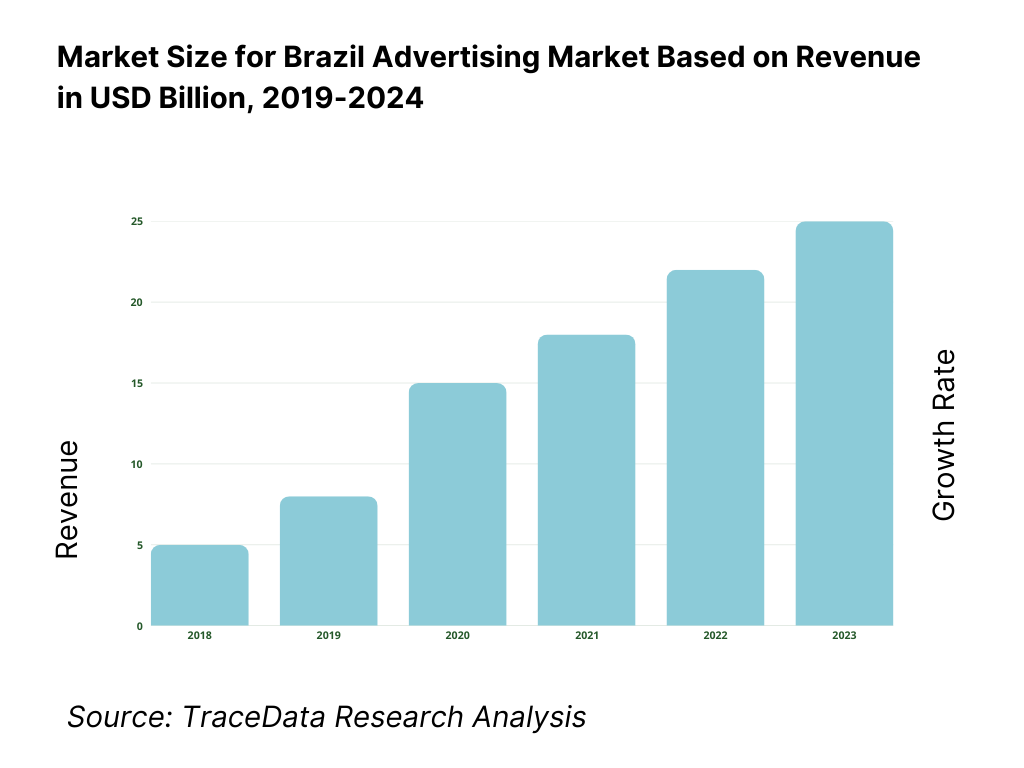
What Factors are Leading to the Growth of the Brazil Advertising Market:
Nationwide digital reach and 5G densification: Brazil’s advertising addressability is expanding on the back of pervasive connectivity. The telecom regulator reports 346.9 million access lines across mobile, fixed broadband, fixed telephony and pay TV and confirms 748 municipalities already operating licensed 5G base stations with ~30,000 ERBs and 34 million 5G-ready users. Household internet access also widened to 72.5 million homes and then 74.9 million homes. For media buyers this translates into reliably scalable digital reach across Brazil’s 5,570 municipalities, with new 5G clusters enabling richer formats (short-form video, AR try-ons) and faster landing-page loads outside state capitals.
Frictionless payments supercharge performance marketing: Brazil’s instant-payment backbone (Pix) has become a full-funnel growth engine for advertisers by compressing checkout steps and boosting conversion telemetry. The Central Bank’s data show 63.51 billion Pix transactions clearing R$ 26.455 trillion over the year, with a single-day record of 239.9 million transactions on Black Friday and 5.71 billion transactions settled in a single month (December). These volumes materially enlarge the attributable pool for P2B campaigns, raise signal density for MMM/MTA, and shorten cash-collection cycles in D2C, subscription, marketplaces and SMB lead-gen funnels—turning real-time offers into measurable revenue events that media teams can optimize hour by hour.
Household income scale and labor-market formalization: Advertising demand is ultimately anchored in consumer spend and employment. IBGE reports 103.3 million people employed on average, with 7.4 million unemployed and the average monthly real labor income at R$ 3,225. Countrywide population stands at 212.6 million residents. On the demand side, World Bank data indicate US$ 1.389 trillion in household final consumption expenditure. For brand builders, this depth of wallets and working-age reach sustains continuous demand for CPG, auto, finance, telco and retail messaging, while bolstering omnichannel strategies that link paid media to in-store and app-based purchases.
Which Industry Challenges Have Impacted the Growth of the Brazil Advertising Market:
Uneven infrastructure and regional inventory gaps: Despite rapid rollout, advanced mobile capacity is still concentrated in a minority of municipalities. Anatel confirms 748 cities with licensed 5G base stations against 5,570 total municipalities, implying 4,822 municipalities yet to host 5G ERBs at the time of the report. While IBGE counts 74.9 million internet-connected households, advertising formats that rely on low latency and high throughput (live commerce, UHD video) still face coverage and quality variability beyond the largest metros. This heterogeneity affects frequency capping, viewability and ROAS parity between core and frontier DMAs, requiring granular geo-allocation and creative weightings.
Consumer-protection scrutiny and reputational risk: Brazil’s self-regulatory and public enforcement ecosystems are highly active around advertising ethics and claims. CONAR data summarized in its annual communications show 226 cases judged in the year, with digital formats leading the docket and 43 betting brands condemned for rule breaches. At the state level, Procon-SP registered 255,536 complaints in the year, highlighting the volume of consumer disputes that can spill into paid media. For advertisers and platforms, this means copy, influencer claims and promotions need rigorous substantiation and fast takedown protocols to avoid takedowns, counter-advertising orders and budget waste during investigations.
Data-protection compliance and incident exposure: Targeting and measurement are constrained by a strict privacy regime with escalating enforcement. The ANPD’s sanctioning framework caps fines at R$ 50,000,000 per infraction and allows daily fines up to R$ 50,000,000. The authority launched targeted sweeps—e.g., a December action scrutinizing 20 companies for failing to appoint a DPO or maintain contact channels. Earlier, it levied its first fine totaling R$ 14,400 in a case involving consent and governance breaches. The compliance lift spans consent logs, DPIAs, vendor due diligence and audience-construction controls, raising operational overhead for adtech, publishers and brands alike.
What are the Regulations and Initiatives which have Governed the Market:
LGPD (Lei Geral de Proteção de Dados) and ANPD enforcement: Brazil’s LGPD governs personal-data processing used for ad targeting, lookalikes and attribution. The ANPD’s sanctioning regulation sets fines of up to R$ 50,000,000 per violation and supports daily penalties capped at R$ 50,000,000, in addition to blocking or deleting data. Active cases span major sectors, with public dockets listing investigations into banks and large platforms during 2024. The authority also carried out focused sweeps of 20 companies regarding DPO designations. Advertisers must evidence lawful basis for audience data, provide granular notices, and maintain audit trails for consents and profiling logic to avoid costly enforcement and campaign suspensions.
CONAR (Self-Regulatory Code for Advertising): CONAR’s Brazilian Code of Advertising Self-Regulation governs claims, children’s advertising, sustainability, health, and influencer disclosures. Its statistical dashboards and annual bulletins show sustained adjudication activity, with hundreds of processes judged in the year and sectoral surges around gambling, alcohol and digital creators; a published tally notes 226 cases judged and 43 betting brands condemned. Remedies include immediate ad suspension, alteration mandates and counter-advertising. For market operators, pre-clearance workflows, influencer contract clauses and substantiation files are practical “licenses to operate,” reducing downstream litigation and spend loss on pulled creatives.
Consumer Defense Code (CDC) and state PROCONs: The CDC forbids misleading or abusive advertising and empowers authorities to order counter-advertising, suspend activities and impose fines; enforcement guides detail these sanctions under Article 56. Operationally, state PROCONs process high complaint volumes that can trigger advertising reviews; Procon-SP logged 255,536 complaints in its 2024 register. Advertisers should maintain offer-pricing evidence, delivery-capability logs during peak events (e.g., Black Friday) and a playbook for rapid corrections on claims—particularly in categories like telecom, retail and betting where complaint inflows surge during promotions.
Brazil Advertising Market Segmentation
By Channel Type: Brazil’s advertising market divides into traditional media and digital media. Digital media commands a dominant, propelled by the exponential rise of mobile internet users, social platforms, and retail media integration across e-commerce sites. Consumers increasingly engage with digital and streaming platforms, drawing advertisers to allocate higher shares to programmatic buying, social feed placements, and search ads. Meanwhile, traditional media—including TV, OOH, print, and radio owing to its enduring reach in regional and older demographics, strong brand impact for mass-market campaigns, and legacy infrastructure that still delivers large-scale visibility.
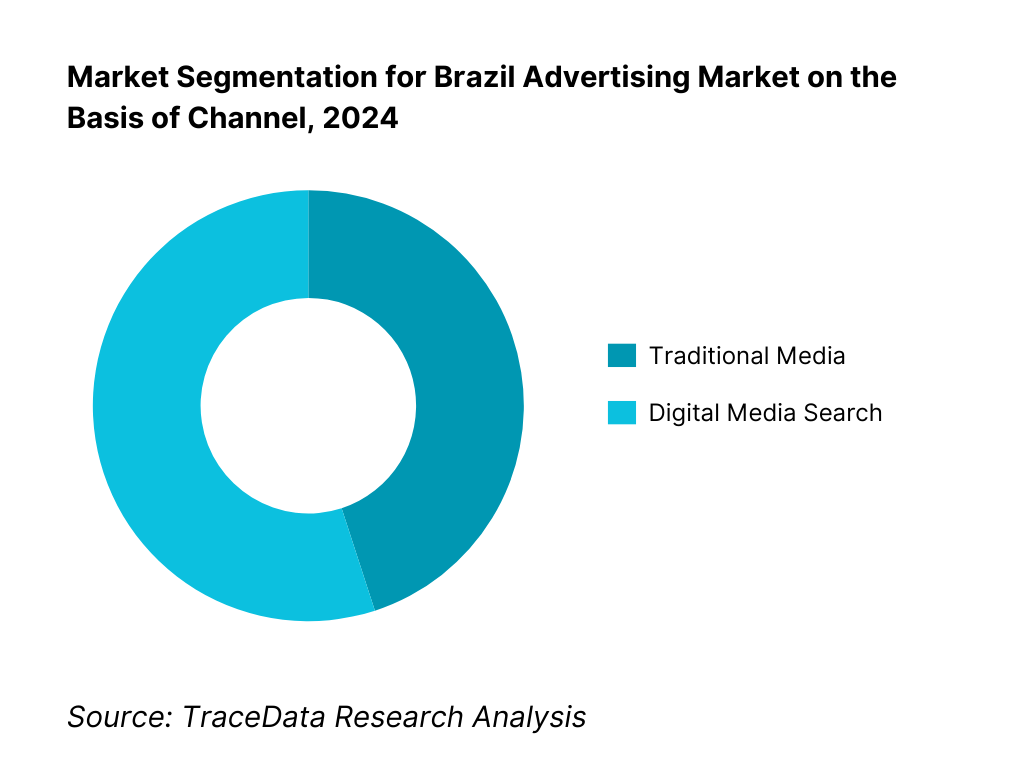
By Advertiser Vertical: Within Brazil's advertiser verticals, FMCG advertisers—including beverage, food, and personal care brands dominates ad spend. Their dominance is fueled by mass-market appeal, frequent product launches, and high media frequency needs. Trust and brand loyalty also play large roles in media placement strategies. Close behind, Retail & E‑commerce grabs 18%, reflecting the e‑commerce boom and adoption of retail media networks. These advertisers increasingly embed ads within platforms like Magazine Luiza and Mercado Livre to directly influence purchase intent and leverage real-time campaign optimization.
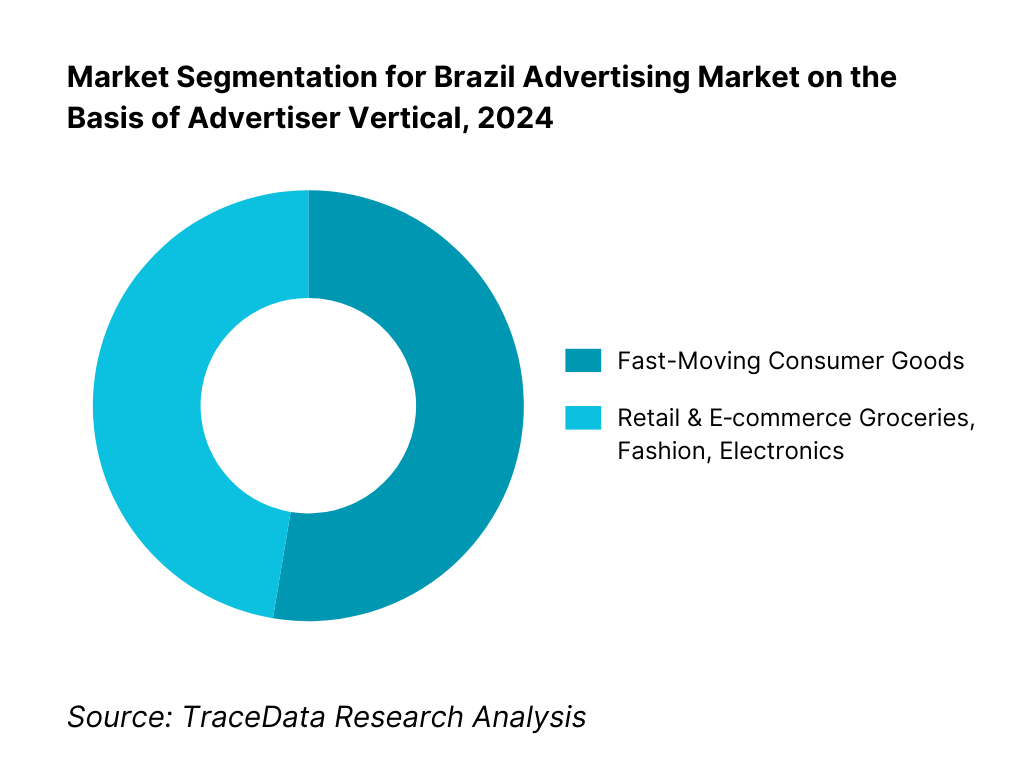
Competitive Landscape in Brazil Advertising Market
The Brazil advertising market is shaped by both powerhouse global networks and strong local players, reflected in billings, integrated media planning, retail media strategies, and digital innovation. This consolidation underscores the importance of scale, data access, and cross-channel capabilities.
Name | Founding Year | Original Headquarters |
WMcCann | 2010 | São Paulo, Brazil |
Africa Creative | 2002 | São Paulo, Brazil |
AlmapBBDO | 1968 | São Paulo, Brazil |
Publicis Brasil (Publicis Worldwide) | 1926 | Paris, France |
Ogilvy Brasil | 1948 | New York, USA |
GALERIA.ag | 2021 | São Paulo, Brazil |
BETC Havas | 1994 | Paris, France |
DPZ&T | 2015 | São Paulo, Brazil |
Artplan | 1967 | Rio de Janeiro, Brazil |
Talent Marcel | 1980 | São Paulo, Brazil |
VML Brasil | 1992 | Kansas City, USA |
Suno United Creators | 2017 | São Paulo, Brazil |
EssenceMediacom Brasil | 2023 | London, UK |
Wieden+Kennedy São Paulo | 1982 | Portland, USA |
Mediabrands Brasil (IPG Mediabrands) | 2008 | New York, USA |
Some of the Recent Competitor Trends and Key Information About Competitors Include:
WMcCann: As one of Brazil’s largest agencies, WMcCann strengthened its presence in connected TV advertising in 2024, leveraging partnerships with streaming platforms to deliver integrated campaigns. The agency has also invested in data-driven storytelling, combining consumer insights with branded content.
Africa Creative: Known for its high-impact creative campaigns, Africa Creative expanded its digital-first strategy in 2024, launching AI-powered creative optimization tools to personalize brand messaging. The agency also collaborated with fintech brands to design immersive cross-platform campaigns.
AlmapBBDO: Specializing in long-term brand building, AlmapBBDO enhanced its retail media offerings in 2024, supporting FMCG and e-commerce advertisers in closing the loop between brand awareness and direct sales. It has also scaled its branded content studio for omni-channel campaigns.
Publicis Brasil: With its strong network presence, Publicis Brasil launched a proprietary data and technology lab in 2024 to enhance precision targeting and attribution models. The agency has focused heavily on integrating retail media and e-commerce strategies for multinational consumer brands.
Ogilvy Brasil: Ogilvy Brasil strengthened its influencer and creator partnerships in 2024, aligning with TikTok and Instagram content ecosystems. The agency also expanded its experiential and live-commerce activations, helping clients connect with younger demographics in innovative ways.
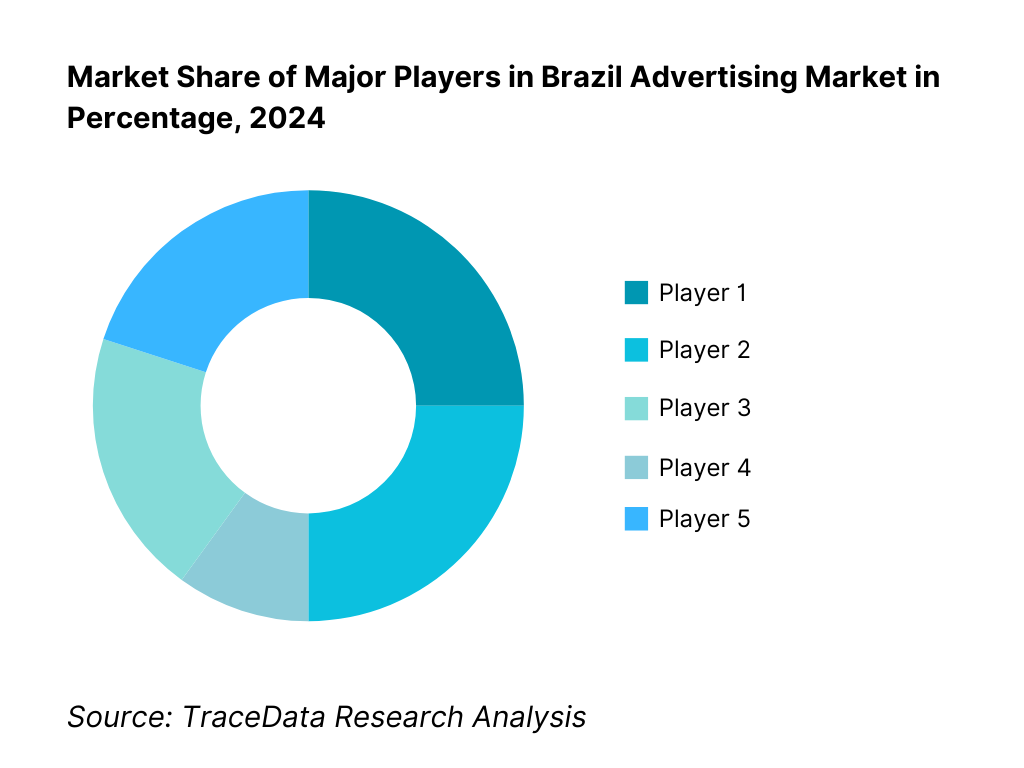
What Lies Ahead for Brazil Advertising Market?
Brazil’s advertising market is set to expand steadily through the forecast horizon as three structural engines converge: the rapid migration of viewing to streaming/CTV, the commercialization of retailer first-party audiences into full-funnel retail media, and frictionless commerce infrastructure (Pix, same-day logistics) that tightens the link between impressions and transactions. Together with AI-enabled creative/media workflows and stricter privacy governance under LGPD that favors consented, higher-quality data, these forces will reward omnichannel strategies that integrate TV/CTV, social/creators, retail media, and programmatic DOOH into measurable, outcome-oriented plans.
Convergence of Retail Media and Brand Building: Retail media networks will move from pure performance hubs to brand-plus-commerce platforms. Onsite placements, offsite audience extension, and clean-room collaboration will let brands plan awareness flights tied to verified sales lift without sacrificing scale. Expect tighter retail–publisher alliances, richer product-feed creative (video, shoppable carousels), and standardized SLAs around attribution windows, incrementality, and data latency. Category leaders will use retailer insights for creative briefing, audience construction, and promotion orchestration, turning trade budgets and classic media budgets into a single, outcomes-managed pool.
CTV and Premium Video Take Center Stage: Ad-supported tiers across global and local streamers, dynamic ad insertion in live sports, and deduplicated cross-screen measurement will push premium video to the core of brand plans. Broadcaster apps, FAST channels, and rights-owner inventory will broaden reach while enabling addressable segments and frequency governance. Marketers will pair mass-reach tentpoles (novelas, football, reality formats) with sequential storytelling across CTV, social video, and short-form to lift aided recall and drive immediate product search/retail media triggers—measured via brand lift, attention metrics, and sales match-backs.
AI-Driven Creative & Media Automation: Generative and predictive AI will compress the creative–media cycle: asset versioning by audience and context, automated concept testing, adaptive storylines, and budget pacing that reacts to attention and conversion signals in near-real-time. On the buy side, curated programmatic pipes and SPO will combine with AI to optimize supply paths, cut IVT, and improve effective reach. On the analytics side, MMM enriched with platform granularities and geo-experiments will become always-on, guiding investment shifts across TV/CTV, social, retail media, and DOOH with clear incrementality reads.
Privacy-First Identity, Clean Rooms & Outcome Trading: With LGPD enforcement intensifying, consented first-party data, modeled cohorts, and publisher/retailer clean rooms will underpin planning and measurement. Identity will become portable through privacy-safe collaborations; frequency and reach will be managed at the cohort level; and outcome-based guarantees (lift, new-to-brand, qualified traffic) will spread beyond walled gardens. Advertisers will formalize governance—consent logs, DPIAs, vendor diligence—and reward partners that deliver transparent data provenance, verifiable quality, and audit-ready reporting.
Programmatic DOOH & Omnichannel Orchestration: Digitized screens, proof-of-play, mobility and weather triggers, and programmatic pipes will push DOOH into the omnichannel video mix. Brands will treat DOOH as an upper-mid funnel video asset, linked to CTV/social sequences and retail media bursts near stores or delivery hotspots. Unified planning will optimize cross-format frequency, using attention and visitation metrics, while creative templates adapt to context (location, time, event). This unlocks large-scale, brand-safe reach beyond living rooms and feeds, with measurable downstream effects.
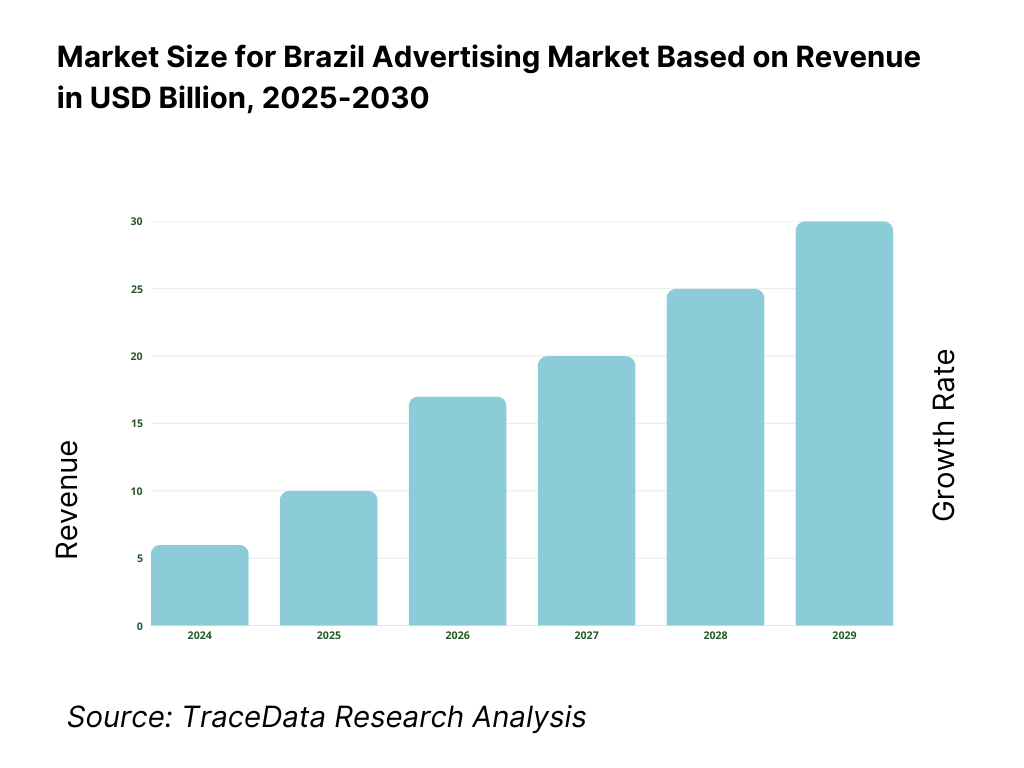
Brazil Advertising Market Segmentation
By Channel Type
Television (Free-to-Air, Pay TV)
Digital (Search, Social Media, Display/Programmatic, CTV/OTT, Retail Media)
Out-of-Home (Traditional OOH, Digital OOH)
Print (Newspapers, Magazines)
Radio & Audio (FM/AM, Digital Audio/Podcasts)
By Advertiser Vertical
FMCG (Food, Beverages, Personal Care, Household Products)
Retail & E-commerce (Groceries, Fashion, Electronics, Marketplaces)
Financial Services (Banking, Fintech, Insurance, Investments)
Automotive & Mobility (Vehicles, Ride-hailing, EVs)
Healthcare & Pharma (OTC, Prescription Drugs, Wellness Brands)
By Buying Method
Direct/Insertion Orders (Traditional Media Buys)
Programmatic (Open Auction, Private Marketplace, Programmatic Guaranteed)
Retail Media (Onsite, Offsite)
Influencer & Affiliate Marketing (Creator Partnerships, Affiliate Networks)
Sponsorships & Partnerships (Sports, Cultural Events, Content Sponsorship)
By Objective / Funnel Stage
Brand Awareness (Mass Media, TV, OOH, Sponsorships)
Consideration (Social Media, Online Video, Display)
Performance/Conversion (Search Ads, Social Performance, Retail Media)
Loyalty & CRM (Email, Retargeting, In-App Messaging)
Trade & Shopper Marketing (In-store Media, Retail Promotions)
By Region
Southeast (São Paulo, Rio de Janeiro)
South (Paraná, Santa Catarina, Rio Grande do Sul)
Northeast (Bahia, Pernambuco, Ceará, etc.)
Center-West (Goiás, Mato Grosso, Distrito Federal)
North (Amazonas, Pará, etc.)
Players Mentioned in the Report:
WMcCann
Africa Creative
AlmapBBDO
Publicis Brasil
Ogilvy Brasil
GALERIA.ag
BETC Havas
DPZ&T
Artplan
Talent Marcel
VML Brasil
Suno United Creators
EssenceMediacom Brasil
Wieden+Kennedy São Paulo
Mediabrands Brasil
Key Target Audience
Large Advertiser CMOs / Heads of Media
Digital Strategy Heads at Major Retailers
Chief Marketing Officers of FMCG Corporations
Heads of Media Investment from Financial Institutions
Brand Directors at Automotive Groups
Investments and Venture Capitalist Firms
Government and Regulatory Bodies (e.g., ANPD, CONAR)
Leading Brazilian Broadcast Network Media Planning Heads
Time Period:
Historical Period: 2019-2024
Base Year: 2025
- Forecast Period: 2025-2030
Report Coverage
Choose individual sections to purchase. Mix and match as you like.
- -
- -
- $100
4.1. Delivery Model Analysis for Advertising Campaigns-Traditional, Digital, Programmatic, Influencer & Retail Media (Margins, Preference, Strength, Weakness)
4.2. Revenue Streams for Brazil Advertising Market (Agency Fees, Media Commissions, Performance-Based, Branded Content, Sponsorships, Retail Media Networks)
4.3. Business Model Canvas for Brazil Advertising Market (Advertiser, Agency, Media Owner, Adtech/Martech Interactions)
$2505.1. Independent Agencies vs. Global Holding Groups
5.2. Investment Model in Brazil Advertising Market (Direct, Programmatic, PMP/PG, BV-based)
5.3. Comparative Analysis of Funneling Process by Local vs. Multinational Advertisers
5.4. Advertising Budget Allocation by Company Size
$150- $100
- $200
8.1. Revenues (in BRL & USD)
$3009.1. By Market Structure (Traditional/Offline, Digital, Hybrid)
9.2. By Advertising Format (TV, Digital Video/CTV, Social Media, Search, Display/Programmatic, OOH/DOOH, Audio, Print, Influencer/Affiliate)
9.3. By Industry Verticals (FMCG, Finance, Automotive, Technology, Healthcare, Retail, Government, Travel & Leisure)
9.3.1. By Type of FMCG Advertising (Mass Media vs. Digital Performance)
9.3.2. By Type of Automotive Advertising (TV Sponsorships vs. Digital/OOH)
9.3.3. By Type of Financial Services Advertising (Brand vs. Performance Campaigns)
9.3.4. By Type of Retail & E-commerce Advertising (Retail Media vs. Influencer)
9.4. By Company Size (Large Enterprises, Medium, SMEs)
9.5. By Consumer Demographics Targeted (Age, Gender, Region, Income Brackets)
9.6. By Mode of Campaign Execution (Direct Buy, Programmatic, Partnership-Based)
9.7. By Creative Type (Standard Display, Rich Media, Video, Native, Branded Content)
9.8. By Region (Southeast, South, Northeast, North, Center-West)
$40010.1. Corporate Advertiser Landscape and Cohort Analysis
10.2. Advertising Needs and Decision-Making Process
10.3. Campaign Effectiveness and ROI Analysis (Brand Lift, Incrementality, Conversion Metrics)
10.4. Gap Analysis Framework
$50011.1. Trends and Developments for Brazil Advertising Market (CTV Growth, Retail Media Networks, AI Creative Optimization, Programmatic DOOH)
11.2. Growth Drivers (E-commerce Penetration, Digital Video Expansion, Social Media Usage, Government Ad Spend, Mobile Internet Growth)
11.3. SWOT Analysis for Brazil Advertising Market
11.4. Issues and Challenges (Transparency in BV Model, Privacy Compliance under LGPD, CTV Measurement Gaps, Ad Fraud/IVT, Inflation Impact)
11.5. Government Regulations (CONAR Code, LGPD, Consumer Code, Children Advertising Rules, Sector-Specific Restrictions)
$20012.1. Market Size and Future Potential for Online/Digital Advertising Industry in Brazil
12.2. Business Model and Revenue Streams (Programmatic, Retail Media, Influencer, Search & Social Ads)
12.3. Delivery Models and Campaign Types (Performance vs. Branding, Video vs. Display, Self-Serve vs. Managed)
12.4. Cross Comparison of Leading Digital Advertising Platforms & Agencies (Company Overview, Investments, Revenues, Clients, Campaign Effectiveness, Pricing, Technology Stack)
$500- $250
- $150
15.1. Market Share of Key Players in Brazil Advertising Market (Basis Revenues)
15.2. Benchmark of Key Competitors Including Company Overview, USP, Business Strategies, Business Model, Clients, Revenues, Pricing, Technology Stack, Best Performing Campaigns, Partnerships, Marketing Strategy, Recent Developments
15.3. Operating Model Analysis Framework
15.4. Gartner Magic Quadrant Equivalent Mapping (Global vs. Local Players)
15.5. Bowmans Strategic Clock for Competitive Advantage
$75016.1. Revenues (Projections)
$30017.1. By Market Structure (Traditional/Offline vs. Digital)
17.2. By Advertising Format (TV, Digital Video/CTV, Social, Search, Display, OOH/DOOH, Audio, Print, Influencer)
17.3. By Industry Verticals (FMCG, Finance, Automotive, Technology, Healthcare, Retail, Travel & Leisure)
17.3.1. By Type of FMCG Advertising
17.3.2. By Type of Automotive Advertising
17.3.3. By Type of Financial Services Advertising
17.3.4. By Type of Retail & E-commerce Advertising
17.4. By Company Size (Large Enterprises, Medium, SMEs)
17.5. By Consumer Demographics Targeted
17.6. By Mode of Campaign Execution (Direct, Programmatic, Retail Media, Partnership)
17.7. By Creative Type (Standard Display, Rich Media, Video, Native, Branded Content)
17.8. By Region (Southeast, South, Northeast, North, Center-West)
$400- $250
- $250
Research Methodology
Step 1: Ecosystem Creation
We begin by mapping the entire Brazil advertising ecosystem, identifying both demand-side entities (advertisers across FMCG, retail, financial services, automotive, technology, healthcare, and government) and supply-side entities (media owners such as TV networks, publishers, digital platforms, OOH operators, and radio stations, alongside agencies, holding groups, and adtech/martech providers). Within this mapping, we shortlist 5–6 leading advertising agencies and holding companies in Brazil based on their billings, digital share of revenues, market reach, and major client portfolios. This mapping leverages industry articles, audited rankings (CENP-Meios), and multiple secondary and proprietary databases to collate sector-level information.
Step 2: Desk Research
Following ecosystem creation, we conduct exhaustive desk research using diverse secondary and proprietary databases. This stage focuses on building an integrated market perspective by consolidating data on advertising revenues, number of active agencies, demand by vertical, channel distribution, pricing benchmarks (CPM, CPP, CPC, CPA), and digital penetration. Company-level insights are derived from press releases, agency annual reports, filings by global holding groups, client announcements, and industry presentations. This comprehensive aggregation process establishes a robust foundation for market sizing and competitive analysis in Brazil.
Step 3: Primary Research
We execute structured, in-depth interviews with C-level executives, media directors, procurement heads, adtech specialists, and brand managers from Brazil’s advertising ecosystem. These interactions serve to validate hypotheses, authenticate statistical estimates, and capture operational/financial insights. Using a bottom-to-top approach, we map revenue contributions of agencies, media owners, and platforms, and aggregate them into the overall market picture. Our methodology also includes disguised interviews, approaching agencies as potential clients to validate financial information, pricing structures, and value propositions. These conversations reveal granular insights into revenue streams, trading models (direct, programmatic, BV), creative operations, margins, and campaign measurement frameworks.
Step 4: Sanity Check
Finally, a sanity check is conducted by combining both top-to-bottom (macroeconomic indicators such as advertising-to-GDP ratios, household consumption levels, and digital penetration) and bottom-to-top (agency billings, media owner revenues, and advertiser spend) approaches. This dual triangulation, reinforced with industry expert validations, ensures accuracy and consistency in market sizing, segmentation, and forecast models. This phase guarantees that the derived numbers and structures align with both macro-level demand drivers and micro-level operational realities of the Brazil advertising industry.
FAQs
01 What is the potential for the Brazil Advertising Market?
The Brazil Advertising Market is poised for substantial growth, underpinned by deep consumer reach, a sophisticated agency–media ecosystem, and rapid digitization across commerce and entertainment. Momentum is coming from streaming/CTV monetization, retail media networks built on first-party data, and frictionless payments that tighten the path from impression to transaction. Strong creative capabilities, robust self-regulation, and expanding programmatic pipes across digital video and DOOH further elevate effectiveness. Together, these drivers position Brazil for sustained expansion and greater outcome-based investment from both global and local advertisers.
02 Who are the Key Players in the Brazil Advertising Market?
The competitive field spans global holding groups and leading independents. Key players include WMcCann, Africa Creative, AlmapBBDO, Publicis Brasil, Ogilvy Brasil, GALERIA.ag, BETC Havas, DPZ&T, Artplan, Talent Marcel, VML Brasil, Suno United Creators, EssenceMediacom Brasil, Wieden+Kennedy São Paulo, and Mediabrands Brasil. These agencies dominate due to integrated creative–media capabilities, retail media and data partnerships, cross-screen video planning (TV/CTV/social), and rigorous brand-safety and measurement stacks aligned with Brazil’s regulatory context.
03 What are the Growth Drivers for the Brazil Advertising Market?
Three structural engines are accelerating spend: (1) Streaming/CTV scale paired with premium local content and dynamic ad insertion; (2) Retail media networks that use retailer first-party data and clean-room collaboration to connect brand investment with verified sales outcomes; and (3) Frictionless commerce infrastructure (e.g., instant payments, same-day logistics) that increases conversion telemetry for performance and full-funnel campaigns. Layered on top are AI-assisted creative ops, expanding programmatic DOOH, and strong social/creator engagement that keeps attention and action within measurable ecosystems.
04 What are the Challenges in the Brazil Advertising Market?
Key headwinds include (1) Measurement fragmentation across TV, CTV, social, retail media, and DOOH, complicating deduplicated reach, frequency, and incrementality; (2) Privacy and compliance lift under LGPD, requiring lawful bases, consent governance, DPIAs, and vendor due diligence that add operational overhead to audience building and attribution; and (3) Quality and safety risks—fraud/IVT, suitability in user-generated environments, and promotional compliance—demanding stronger verification, pre-clearance, and rapid takedown workflows to protect budgets and brand equity.